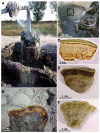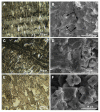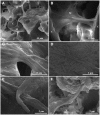Structure, mineralogy, and microbial diversity of geothermal spring microbialites associated with a deep oil drilling in Romania
- PMID: 25870594
- PMCID: PMC4378309
- DOI: 10.3389/fmicb.2015.00253
Structure, mineralogy, and microbial diversity of geothermal spring microbialites associated with a deep oil drilling in Romania
Abstract
Modern mineral deposits play an important role in evolutionary studies by providing clues to the formation of ancient lithified microbial communities. Here we report the presence of microbialite-forming microbial mats in different microenvironments at 32°C, 49°C, and 65°C around the geothermal spring from an abandoned oil drill in Ciocaia, Romania. The mineralogy and the macro- and microstructure of the microbialites were investigated, together with their microbial diversity based on a 16S rRNA gene amplicon sequencing approach. The calcium carbonate is deposited mainly in the form of calcite. At 32°C and 49°C, the microbialites show a laminated structure with visible microbial mat-carbonate crystal interactions. At 65°C, the mineral deposit is clotted, without obvious organic residues. Partial 16S rRNA gene amplicon sequencing showed that the relative abundance of the phylum Archaea was low at 32°C (<0.5%) but increased significantly at 65°C (36%). The bacterial diversity was either similar to other microbialites described in literature (the 32°C sample) or displayed a specific combination of phyla and classes (the 49°C and 65°C samples). Bacterial taxa were distributed among 39 phyla, out of which 14 had inferred abundances >1%. The dominant bacterial groups at 32°C were Cyanobacteria, Gammaproteobacteria, Firmicutes, Bacteroidetes, Chloroflexi, Thermi, Actinobacteria, Planctomycetes, and Defferibacteres. At 49°C, there was a striking dominance of the Gammaproteobacteria, followed by Firmicutes, Bacteroidetes, and Armantimonadetes. The 65°C sample was dominated by Betaproteobacteria, Firmicutes, [OP1], Defferibacteres, Thermi, Thermotogae, [EM3], and Nitrospirae. Several groups from Proteobacteria and Firmicutes, together with Halobacteria and Melainabacteria were described for the first time in calcium carbonate deposits. Overall, the spring from Ciocaia emerges as a valuable site to probe microbes-minerals interrelationships along thermal and geochemical gradients.
Keywords: amplicon sequencing; biomineralization; carbonate; hot springs; microbial diversity; oil drill.
Figures







References
-
- Ahrendt S. R., Mobberley J. M., Visscher P. T., Koss L. L., Foster J. S. (2014). Effects of elevated carbon dioxide and salinity on the microbial diversity in lithifying microbial mats. Minerals 4, 145–169 10.3390/min4010145 - DOI
LinkOut - more resources
Full Text Sources
Other Literature Sources
Molecular Biology Databases

